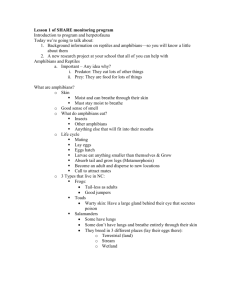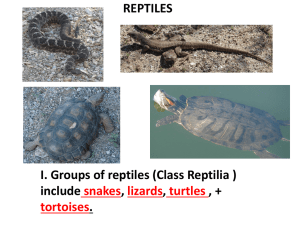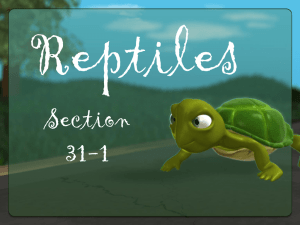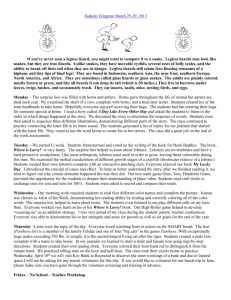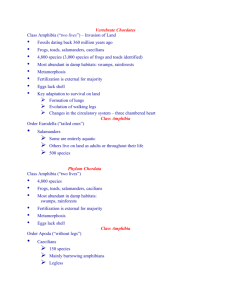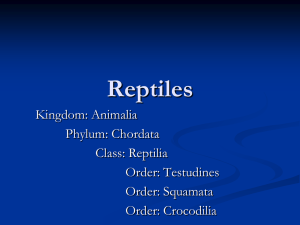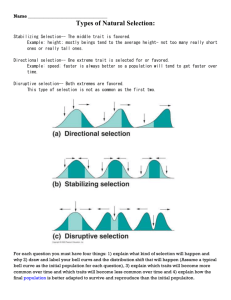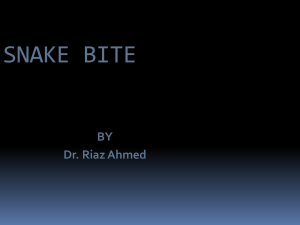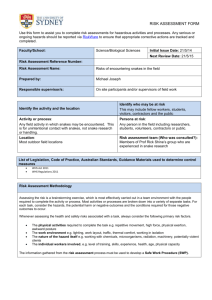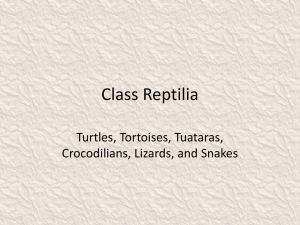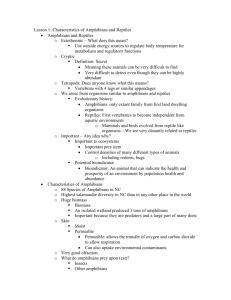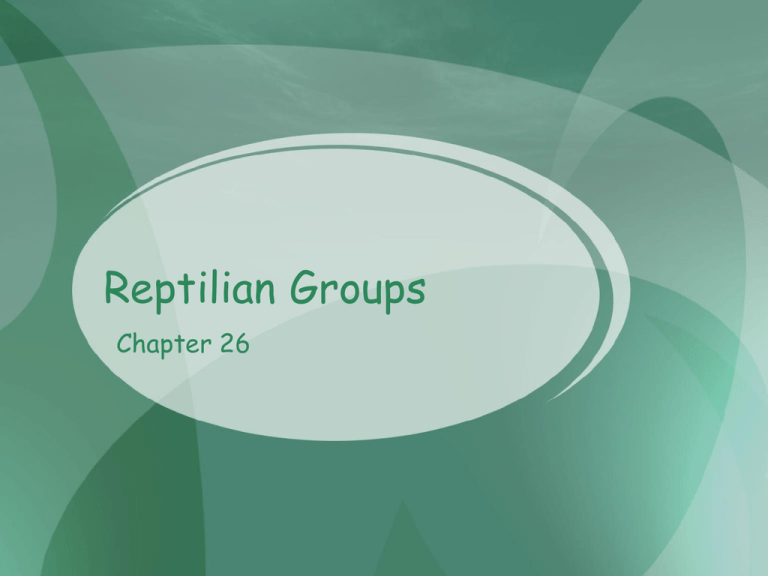
Reptilian Groups
Chapter 26
I. Diversity
First truly terrestrial vertebrates
7000 species; 300 in U.S.
Age of Reptiles lasted over 165 my, including
dinosaurs
Mass extinction at end of Mesozoic; modern
lineages are survivors
Lizards and snakes underwent further radiation
into diverse and abundant groups
Carboniferous Forest
II. Origin & Adaptive Radiation
Arose from amphibian-like
tetrapods, the
anthracosaurs, during
Carboniferous
3 lineages:
Anapsids—turtles
Diapsids—
ichthyosaurs, lizards,
snakes, crocodilians,
tuatara, plesiosaurs;
this lineage also gave
rise to birds
Synapsids—mammallike reptiles (all
extinct)
Tetrapod Skulls
III. Characteristics
A. Skin
Tough, dry, scaly which
protects and prevents
dessication
Epidermis shed periodically
in lizards and snakes;
formed of scales made of
keratin
Turtles add new layers
under old, forming platelike
scutes
Crocodiles and many lizards
also have bony plates called
osteoderms beneath scales
Thicker dermis has
chromatophores that
provide color
B. Shelled Egg
Main factor in reptiles success
Shell permits eggs to be laid
on land; porous, parchment-like
or leathery
Extraembryonic membranes
from previous aquatic stages
maintained; protective
membranes support
development
Allantois is respiratory
surface and chamber for
storing waste
Chorion allows oxygen and
carbon dioxide to pass easily
Young hatch as lung-breathing
mini adults
C. Reptilian Jaws
Jaw muscles become larger to allow for
mechanics of chewing
D. Internal Fertilization
Required because sperm
must reach egg before it
is enclosed
Males have copulatory
organ; testes produce
sperm
Female has oviducts and
paired ovaries; oviducts
secrete albumin and shells
for eggs
E. Circulatory System Changes
Right and left atria completely partitioned
Right atrium receives deoxygenated blood from
body; left oxygenated blood from lungs
Ventricle incompletely separated but only a little
mixture of the blood occurs
In crocodilians, ventricles are completely
separated
Blood pressure is also higher than amphibians
F. Lungs
Better developed
Pull air in by enlarging
thoracic cavity:
Snakes and lizards
move rib cage
Turtles and
crocodilians move
internal organs to
create negative
pressure
G. Water Conservation
Metanephric kidney which concentrates solutes
and excretes wastes as uric acid; uric acid has
low solubility and precipitates readily requiring
less water for elimination
Salt glands nears eyes or nose secrete excess
salts
H. Support of Limbs for
Locomotion
Better body support (except limbless reptiles)
Walk with legs splayed outwards and body close
to ground
Most dinosaurs and some modern lizards have
more efficient method with legs directed
beneath body
I. Nervous System
More complex
Brain small but cerebrum a little larger; in
crocodilians a true cerebral cortex permitting
more complex behaviors
Sense organs well developed except hearing
Jacobson’s organ is highly developed in lizards
and snakes to detect odors carried to senses by
tongue
IV. Reptilian Orders
A. Anapsida; Order Testudines
1. General Characteristics
Appeared in Triassic, 200 mya
Shells have dorsal carapace and ventral plastron;
outer horny layer and inner layer of bone
Limbs and limb girdles far from ribs
No teeth; use horny plates to rip food
2. Respiration
Can’t expand chest because of rigid shell
Movement of abdominal and pectoral muscles
associated with limbs create space for air to
move in or compress viscera to push air out
Movement of limbs helps ventilate lungs
Some aquatic turtles gain enough oxygen by
pumping water in and out of mouth cavity
3. Reproduction
Oviparous
Eggs buried in ground in nest; no care of young
In crocodiles, some turtle families, and some
lizards, nest temperature determines sex of
offspring; low temperatures are males and higher
temperatures are females
4. Types
Giant turtles
Marine turtles may reach 2 m long and 725 kg in
weight; Galapagos tortoises reach several hundred
kilograms
Low metabolic activity allows lifespan of 150 yrs
Box turtle
Hinged plastron allows it pull in all parts and close up
completely
Snapping turtles
Reduced shell prevents full withdrawl of body
Strong jaws used defensively and for hunting
Eat fish, frogs, waterfowl
B. Diapsida; Order Squamata
Most recent and diverse, making up 95% of living
reptiles
Lizards appeared in Permian but did not radiate
until Cretaceous
Snakes appeared in late Cretaceous
Amphisbaenas appeared in early Cenozoic
a. General Characteristics
Lost dermal bone by temporal opening allowing
for a kinetic skull, one that has movable joints
Can seize and manipulate prey with jaws and
force jaws closed
Skull mobility is major factor in diversity
b. Reproduction
Some viviparous or ovoviviparous;associated with
colder climates. Eggs retained longer in oviduct
Oviparous; associated with warmer climates
c. Suborder: Sauria
Terrestrial, burrowing, aquatic, aerial, arboreal
Survive well in hot, dry regions
External ear; day-active lizards have rods & cones;
nocturnal have only rods
Keep body temperature constant by behavioral regulation
Conserve water by producing semisolid urine with highly
crystalline uric acid
Some store fat in tails to provide energy and water
during drought
Geckos—small, nocturnal, adhesive pads on toes
Chameleons—arboreal, color changing, long tongue
Iguanids—many New World lizards
Gila monster, beaded lizard, and komodo dragon only ones
with venomous bites
Lizards
d. Suborder: Amphisbaenia
Most lack any trace of external limbs; skin in
rings; resemble earthworms
Eyes and ears rudimentary and hidden under skin
1 species in Florida but mainly South America and
tropical Africa
e. Suborder: Serpentes
(1) Feeding
Can eat prey several times their own diameter
Two halves are loosely joined allowing them to
spread apart
Skull bones loosely articulated so mouth can
accommodate large prey
To allow breathing during slow process of
swallowing, tracheal opening extended
Has extra skin infolded between scales; this
unfolds during a big meal
Hunting and Feeding
(2) Senses
Eyes have reduced mobility and
permanent corneal membrane for
protection
Most have poor vision except
arboreal snakes
No external ear and do not
respond to sounds
Can feel vibrations, especially low
frequencies, and those in ground
Chemical senses primary on used
for hunting
Jacobson’s organs are pair of
pits in roof of mouth; lined with
olfactory receptors and forked
tongue picks up particles and
conveys them past organ
Pit vipers( rattlesnakes) have pits
that detect heat emitted by
warm-bodied prey
(3) Movement
Limbless and have lost
pectoral and pelvic girdles
(except pythons)
Vertebrae shorter and wider
to allow undulation
Lateral undulation is Sshaped movement that pushes
against rough ground and
water
Concertina movement is
extension of S-shaped loops
to strike or to climb trees
Rectilinear movement is
straight using minute lifting
of consecutive ribs
Sidewinding is sideways
looping by desert vipers that
“walks” them across sand
(4) Venom/Venomous Snakes
Vipers have hollow fangs that are hinged and
inject venom as snake strikes
Family Viperidae—New World and Old World
vipers with and without pits
Family Elapidae—cobras, mambas, coral snakes,
and kraits
Family Hydrophiidae—sea snakes
Family Colubridae—most non venomous but
boomslang and African twig snake are
Venomous Snakes
Fangs
(5) Snakebites
8000 snake bites each year in
U.S.; 12 fatal; In India and
Burma alone 200,000
bites/year; 25,000 fatalities
worldwide
Most venom a combination of
types
Neurotoxins act on nervous
system causing blindness and
stopping respiration
Hemorrhagin type breaks
down blood vessels, allowing
blood to leak into spaces
Sea snakes and Australian
tiger snake have most deadly
venom per unit but large
venomous snakes deliver more
venom, making the king cobra
the most dangerous
“Red next to yellow, kill a fellow.”
Snake Bites
(6) Reproduction
Most oviparous, laying
eggs under logs, rocks, or
in holes
Pit vipers are
ovoviviparous
Some are viviparous
Sperm may be retained
and several egg clutches
can be laid from a single
mating
f. Order Sphenodonta
Tuatara sole survivor of group
that evolved 200 mya and went
extinct 100 mya
3 species live in New Zealand;
once widespread but now
restricted to small islands
Has a well developed median
parietal eye buried beneath
the skin; function is unknown
Lives in burrows
Slow growing and may live to 77
years
Slowest rates of evolution
among vertebrates
g. Order Crocodilia
Sole survivor of archosaurs; group radiated
into dinosaurs and birds
Have changed little since evolved in Mesozoic
Long, well reinforced skull and jaw muscles
for powerful bite; teeth set in sockets
Complete secondary palate; feature only
shared with mammals; 4 chambered heart
like birds and mammals
Oviparous, laying eggs in nest of vegetation
Alligators and caimans—New World—broad
snout
Crocodiles—widely distributed; also
saltwater
Gavials—India and Burma—very narrow snout
Crocodilians

